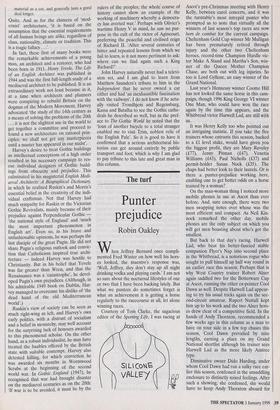Not motoring
Against the God juggernaut
Gavin Stamp
Alas, I never met or corresponded with John Harvey ŌĆö so it is exasperating that he is gone as there is much I should now like to ask him. The trouble was I thought he had died long ago, only recently discover- ing that he was still alive. Too late now. But this was because his books of the 1940s ŌĆö with their beautiful dust-jackets designed by the author ŌĆö read like the works of an old and wise man, in both lan- guage and opinions. In these, he not only displayed an intimate and comprehensive knowledge of the mediaeval buildings of Europe and beyond, but a deep sympathy with the culture of the late Middle Ages which had echoes of Morris and Pugin.
He wrote in The Gothic World (1950):
I believe the Gothic Age, to have had an essentially greater significance in human development than the centuries of apparently greater material achievement which have succeeded it ... Upon reflection, it is not clear that mechanical inventions from the printing press to the atomic bomb have increased the human perception of beauty, the greatest good of the greatest number, or happiness and health. A cathedral is quite as material as a car, and generally lasts a good deal longer.
Quite. And as for the chimera of 'mod- ernist' architecture, 'it is based on the assumption that the essential requirements of all human beings are alike, regardless of class, nationality, climate or tradition. This is a tragic fallacy ...' In fact, these first of many books were the remarkable achievements of a young man, an architect and a restorer, who had been born in 1911. Henry Yevele, The Life of an English Architect was published in 1944 and was the first full-length study of a mediaeval architect to be published. It is an extraordinary work not least because in it, at a time when architects and planners were conspiring to rebuild Britain on the dogmas of the Modern Movement, Harvey advocated 'the study of the 14th century as a means of solving the problems of the 20th . it is not the slightest use in the world to get together a committee and proceed to found a new architecture on rational prin- ciples: we shall not get any masterpieces until a master has appeared in our midst'. Harvey's desire to treat Gothic buildings as intellectual conceptions of a high order resulted in his necessary campaign to res- cue individual designers of Gothic build- ings from obscurity and prejudice. This culminated in his magisterial English Medi- aeval Architects: A Biographical Dictionary, in which he realised Ruskin's and Morris's essential belief in the creativity of the indi- vidual craftsman. Not that Harvey had much sympathy for Ruskin or the Victorian Gothic Revivalists, mainly because of their prejudice against Perpendicular Gothic 'the national style of England' and 'much the most important phenomenon in English art'. Even so, in his brave and unfashionable opinions, he was perhaps the last disciple of the great Pugin. He did not share Pugin's religious outlook and convic- tion that Catholicism inspired true archi- tecture ŌĆö indeed Harvey was hostile to Christianity. But in his belief that Yevele was far greater than Wren, and that the Renaissance was a 'catastrophe', he devel- oped Pugin's own prejudices. (Although, in his admirable 1949 book on Dublin, Har- vey managed to overcome his dislike of 'the dead hand of the old Mediterranean world'.) Ruskin's view of society can be seen as much right-wing as left, and Harvey's own early politics, with a distrust of socialism and a belief in monarchy, may well account for the surprising lack of honours awarded to this phenomenal scholar. On the other hand, as a robust individualist, he may have treated the baubles offered by the British state with suitable contempt. Harvey also detested killing, for which conviction he was awarded six months in Wormwood Scrubs at the beginning of the second world war. In Gothic England (1947), he recognised that war had brought disaster on the mediaeval centuries as on the 20th: `If war is to be avoided, it must be by the rulers of the peoples; the whole course of history cannot show an example of the working of machinery whereby a democra- cy has averted war.' Perhaps with Olivier's wartime Henry V in mind, he saw no pur- pose in the cult of the victor of Agincourt, preferring the peaceful and civilised reign of Richard II. 'After several centuries of bitter and repeated lessons from which we fail to learn, is it not more pertinent to ask: where can we find again such a King Richard?'
John Harvey naturally never had a televi- sion set, and I am glad to learn from Matthew Saunders's tribute to him in the Independent that he never owned a car either and had 'an inexhaustible fascination with the railways'. I do not know if he actu- ally visited Trondhjem and Regensburg, Kassa and Batalha to see the Gothic cathe- drals he described so well, but in the pref- ace to The Gothic World he noted that the `loan of another bicycle to a total stranger enabled me to visit Trim, noblest relic of the English Pale'. So it is good to have it confirmed that a serious architectural his- torian can get around entirely by public transport and foot, which is why I am glad to pay tribute to this late and great man in this column.



















































 Previous page
Previous page